Questions? Email me:
dave@santorinidave.com
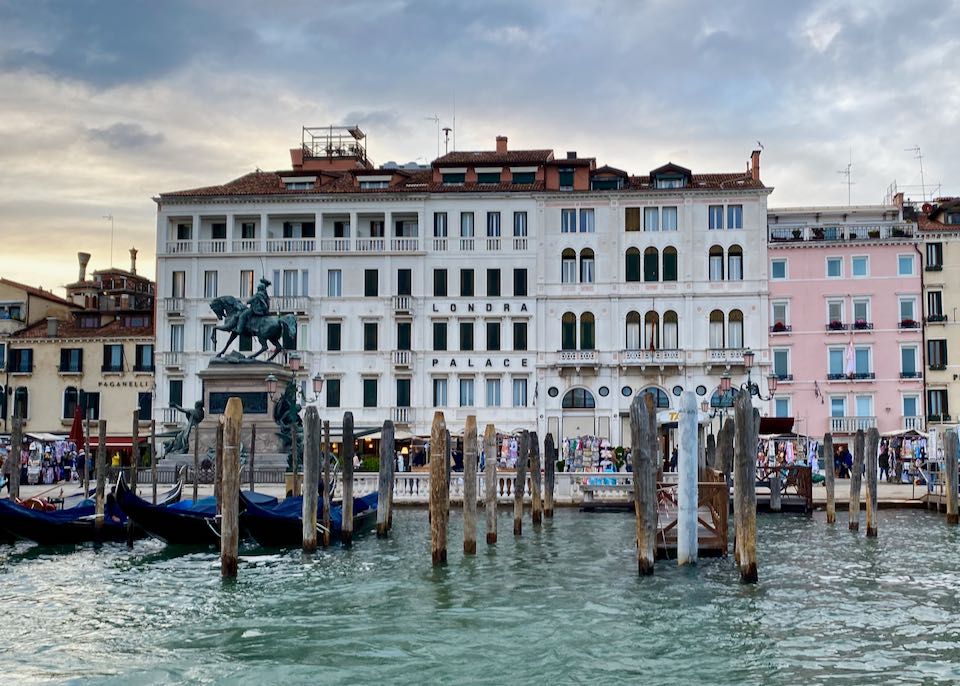
Sitting right on the Grand Canal, the elegant Londra Palace is one of our favorite luxury hotels in Venice.
The Best Areas to Stay in Venice
There’s no city in the world quite like Venice. A series of seemingly impossible man-made islands set in a lagoon, traversed only on foot or by boat, Venice brims with show-stopping architecture and incredible artwork. Its name alone evokes romantic gondola rides along scenic canals. There’s good reason this once-independent republic at the northern end of the Adriatic has been inspiring imitations for centuries.
Despite being mobbed by tourists, it’s surprisingly easy to lose the crowds here, along narrow calli (streets) that suddenly open up to glorious art-covered churches or mesmerizing vistas. And while there is no single “best” neighborhood to stay in, your chosen location will dictate the feel of your experience, as well as the amount of time spent walking and/or taking vaporetti (water buses) to get around. Venice’s biggest attractions are concentrated in the central sestiere of San Marco, followed by Dorsoduro and Cannaregio.
Venice Neighborhoods and Sestieri
Me and my two sons catching a ride on water taxi through the canals of Venice.
Situated on marshy islands about 2.5 miles (4 km) offshore, Venice is linked to the mainland district of Mestre via the Ponte della Libertà. While vehicles can traverse the bridge into the city, they can only proceed as far as Piazzale Roma. The city’s six central districts, or sestieri — San Marco, Castello, Dorsoduro, San Polo, Santa Croce, and Cannaregio — are clustered within the heart of the Venetian Lagoon and surround the Grand Canal, Venice’s watery main drag that snakes through the heart of the city. The greater Venice area also encompasses several outlying islands to the south and north, as well as the Lido to the east. There are excellent Venice hotels all over the city, though many of the best are concentrated in the most popular sestieri.
In the heart of Venice and separated from San Polo and Dorsoduro by the Grand Canal, San Marco is the oldest and grandest part of the city, where you’ll find the vast Piazza San Marco surrounded by iconic architecture. It’s also the most touristy and crowded, with a busy vaporetto hub and hordes of visitors day and night, particularly along the waterfront. Away from Piazza San Marco, the area’s tiny streets are quieter and a joy to explore.
View over Venice’s Grand Canal from the Rialto Bridge.
Adjoining San Marco to the east is Castello, Venice’s largest neighborhood, with the Arsenale (historic shipyard) at its heart. Despite its proximity to tourist central, the pace of local life in most of Castello is sedate and serene, partly assisted by the presence of the city’s biggest park and proliferation of tiny, tranquil plazas. Some of the city’s most important churches are found here, too.
Across the Grand Canal from San Marco to the southwest, Dorsoduro offers a fantastic mix of heavyweight attractions and authentic local life. Apart from major art galleries and palaces, this district has some excellent places to eat (including a neighborhood produce market) and lively nightlife, fueled by the large student population of Ca’ Foscari University.
Officially part of the Dorsoduro sestiere, but on a separate island south of the Giudecca Canal, the neighborhood of Giudecca has worn many hats over the centuries, from a place of exile and aristocrat retreat to an industrial hub and military barracks. Sitting in the shadow of several beautiful churches, it’s a low-key part of the city and home to many artists’ studios.
A labyrinth of centuries-old lanes, San Polo is not only Venice’s smallest neighborhood but also one of the most historically significant. West of San Marco and across the Grand Canal via the famous Rialto Bridge, San Polo is packed with beautiful churches and boasts some of Venice’s best restaurants and a bustling produce market. There are some excellent neighborhood bars here, with a handful clustered around Campo San Polo.
Santa Croce borders San Polo to the west and is the city’s least touristy neighborhood; home to the bus station, city parking area, and vaporetto hub. Alongside affordable accommodations and old-school, family-run restaurants (there are particularly rich pickings around Campo San Giacomo dall’Orio), there’s a handful of sights here with a focus on contemporary art and natural history. All an easy walk to San Polo’s nightlife.
Cannaregio, in the northern part of the city, encompasses the world’s first Jewish ghetto and is home to beautiful synagogues and a museum of Jewish history. It’s situated north across the Grand Canal from Santa Croce and San Polo, and bordered by San Marco and Castello to the south and east. Densely inhabited by Venetians, this is one of the city’s most authentic neighborhoods, with low-key bars and eateries, as well as the main train station, Venezia Santa Lucia.
Murano is just north of Venice proper, reachable via a short vaporetto ride from Cannaregio. The island has a long and illustrious history of glass-making – Murano glass creations are still considered among the world’s finest. Murano also makes a great home base for those looking for a quiet and unique part of the city to stay in.
Almost an hour’s vaporetto ride from Cannaregio, Burano is a smaller island in the northern part of the Venetian lagoon, famous for its its colorful fishermen’s houses and long history of elaborate lacemaking.
Distinct from the rest of Venice, Lido de Venezia is characterized by its elongated shape, straight streets, beaches, and vehicular traffic. Situated east of the main city, Lido is a 7-mile-long barrier island that separates the Venetian Lagoon from the Adriatic Sea. Accessible via vaporetto from the Castello or Cannaregio districts, Lido boasts a sandy beach, striking art deco architecture, and a selection of excellent seafood restaurants.
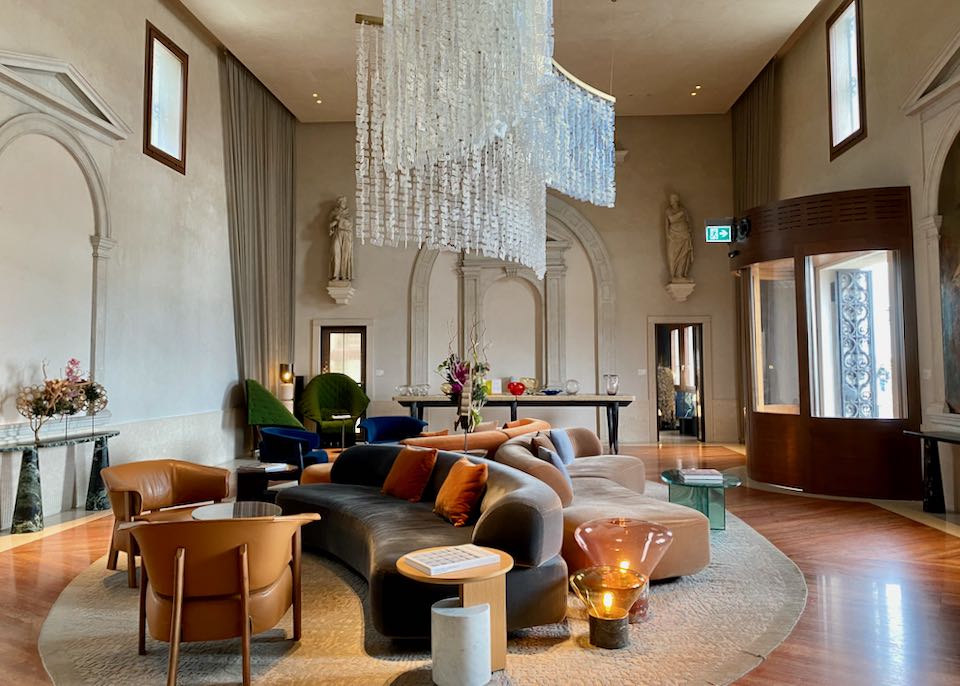
The modern and elegant lobby of Ca’ di Dio hotel in Venice’s Castello sestiere.
Getting Around Venice
Venice is wonderfully walkable, but getting from the northern fringes of Cannaregio to Piazza San Marco can be time-consuming, and you’ll likely want to rely on water transport at some point. Vaporetti (water buses) chug along the Grand Canal and around all the main sestieri, offering a scenic – and often time-saving – way to get from point A to B. The most
useful routes are the no. 2 express, running between the train station and San Marco in around 30 minutes along the Grand Canal; and the slower no. 1, which makes 13 stops along the same route – take this one in the early morning for a cheap sightseeing cruise.Single tickets are €7.50 and a 24-hour ACTV travel card is €20, so it only takes three trips to save money with the card. Multi-day cards are offered for longer stays: €30 for 2 days, €40 for 3 days, €60 for 7-days. Single tickets and travel cards can be purchased at ACTV machines on the vaporetti docks or at HelloVenezia ticket windows.
Note that you must validate all tickets in the dock’s ticket validation machines before getting aboard. If inspectors find you without a validated ticket (and they often check) you’ll be given a hefty fine on the spot, no excuses.
The Best Places to Stay in Venice
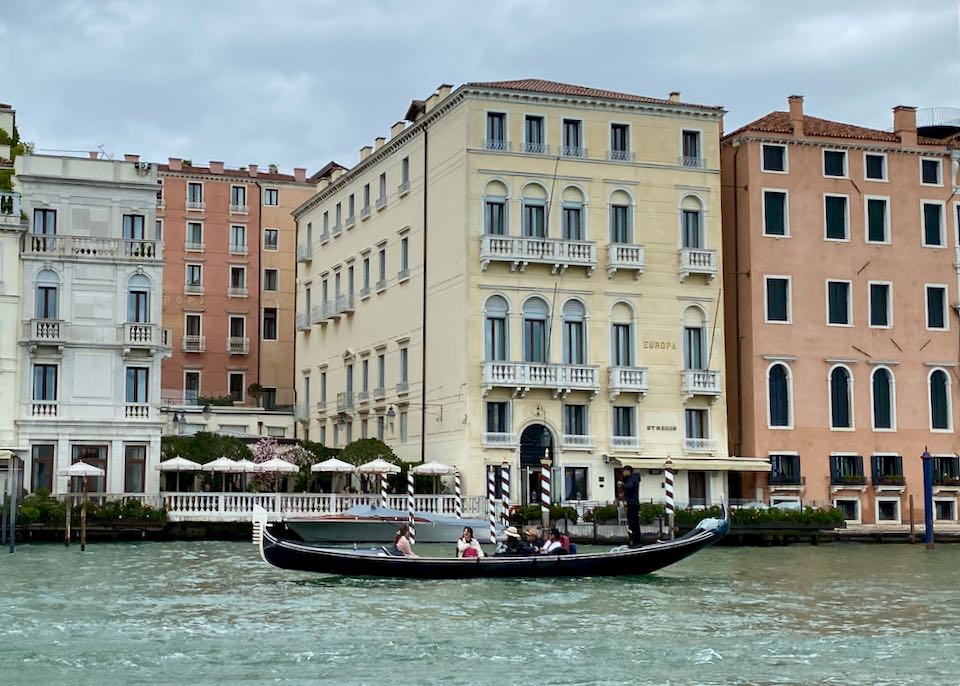
The remarkable St. Regis Hotel on the Grand Canal in the San Marco area of central Venice.
- Best Luxury Hotels in Venice
Ca’ Bonfadini • Cipriani • Gritti Palace • Londra Palace • Nani Mocenigo Palace • Palazzo Nani • St Regis • Aman Venice- Best Boutique Hotels in Venice
Al Ponte Antico • Arcadia • Ca’di Dio • Ca Maria Adele • Corte di Gabriela • Egò The Silk Road • Indigo Sant’Elena • Novecento • Santa Croce- Best Cheap & Midrange Hotels in Venice
Albergo Marin • All’Angelo Art Hotel • B&B Bloom Settimo Cielo • La Residenza- Best Hotels for Families in Venice
Bisanzio • American Dinesen • OlimpiaOur suite (the quadruple room) at the Hotel Bisanzio in Venice.
Best Areas in Venice for…
- Best Neighborhoods in Venice for Sightseeing: San Marco, Dorsoduro, Cannaregio
Venice’s most popular sights are concentrated around or near Piazza San Marco, making San Marco is a natural choice for those looking to maximize their time. Visitors who are specifically interested in art will appreciate Dorsoduro’s concentration of heavyweight galleries and museums along the Grand Canal, an easy walk from San Marco. And if Jewish history is your passion, you can’t leave Venice without visiting the centuries-old Jewish ghetto, museum, and synagogues in Cannaregio.Al Ponte Antico in Cannaregio is one of only a few hotels with a terrace offering a view of the Rialto Bridge.
- Best Neighborhoods in Venice for Nightlife: Dorsoduro, San Polo, Santa Croce
Venice isn’t particularly renowned for its nightlife, but Dorsoduro is popular for its cluster of lively bars that are concentrated mostly around Campo Santa Margherita, fueled by the large student contingent residing in the neighborhood; Caffe Rosso, Margaret DuChamp, and Skillà Bar are popular spots.For a more sedate drinking scene, it’s worth trying the bars in the tiny streets of San Polo (Il Mercante for cocktails and La Bottiglia for wine), and also around Campo San Giacomo dell’Orio in Santa Croce; Al Prosecco here is the best place to sample the region’s famous bubbly or spritz (the bright orange mix of Prosecco and Aperol you’ll see being sipped everywhere in Venice).
- Best Neighborhoods in Venice for Food and Restaurants: Dorsoduro (but also San Polo, Cannaregio, San Marco,& Castello)
We like the Dorsoduro neighborhood best when it comes to eating in Venice – quality tends to be better and the prices a little cheaper than anywhere else – but the truth is there is no single best neighborhood for eating out in Venice, and the overall quality of restaurant food in the city tends to be pricier and poorer than in other parts of Italy. That said, this is still Italy: there are some terrific places to try, particularly for Venetian specialties of lagoon fish and seafood, ranging from Michelin-starred creative cuisine to hearty meals in the family-run, neighborhood osterias and “bàcari” (local bars) that serve ciccheti (Venetian tapas), best sampled with a glass of local wine, Prosecco, or spritz.Try to avoid photo-laden “menù turisticos” and remember that value and quality tend to increase the further you stray from St Mark’s Square. In Dorsoduro, we like the local dishes served at family-owned Ai Artisti, the history and garden at Locanda Montin (beloved by Peggy Guggenheim and a host of luminaries), the no-frills Venetian cooking at Ai Cugnai, the view of the gondolas across the canal at Osteria Al Squero and the sublime gelato at Il Doge. Bacareto da Lele, just to the north in Santa Croce, is another gem, a tiny bar where students sit on the church steps nearby to sip prosecco and snack on tasty cicchetti.
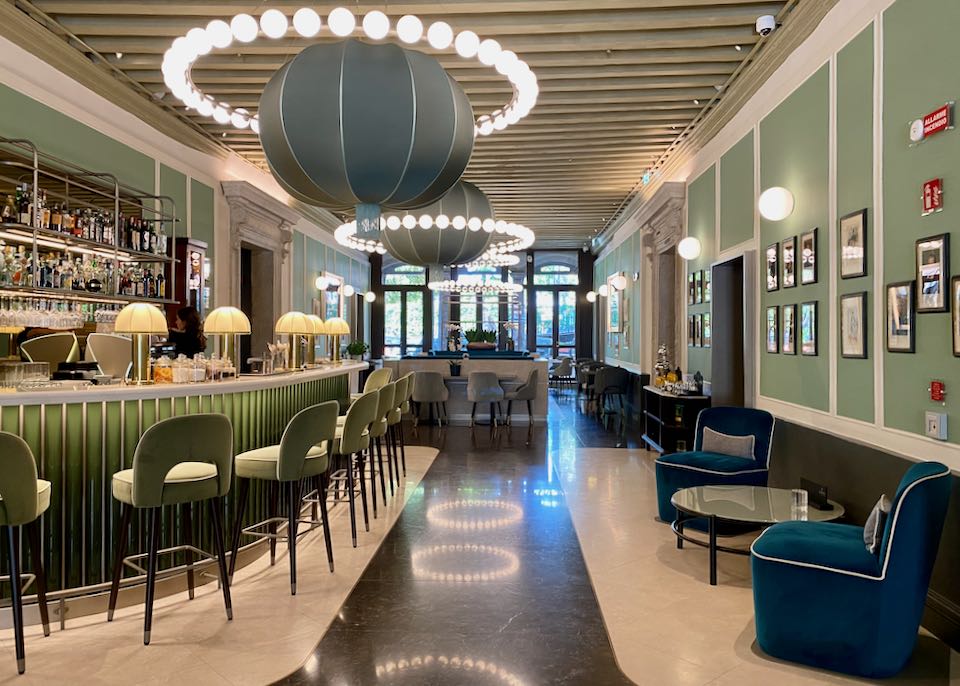
The stylish bar of Venice’s Palazzo Nani hotel.
- Best Neighborhoods in Venice for Families: Castello, Lido de Venezia, Giudecca
Castello is a good choice, particularly the quieter eastern end, where you’ll find the Giardini della Biennale, Venice’s largest (and only real) park; it’s only three stops on the vaporetto from the Piazza San Marco. You’ll also find the Stadio Pier Luigi Penzo out here, home of local soccer club Venezia F.C. and surely one of the most scenically located stadiums anywhere. The Lido is very family-friendly in the summer, with a large beach, playgrounds, and parks and hotels catering to families, but it’s a 25-minute vaporetto ride from Venice’s main attractions. It’s also worth considering Giudecca, a short vaporetto hop from San Marco and very quiet compared to most other sestieri.- Best Neighborhood in Venice to Stay for First Timers: San Marco or Dorsoduro
If you dream of stepping out of your hotel and finding yourself on the Rialto Bridge, or of turning a corner and ending up on the Piazza di San Marco, then San Marco is the sestiere for you. It’s a particularly good base if your time in Venice is limited, since that’s where many of Venice’s top attractions are concentrated. Alternatively, consider staying in Dorsoduro, also packed with attractions and just across the Accademia Bridge from San Marco, or in the western part of San Polo near the Rialto Bridge, since you’d be an easy walk or short vaporetto ride from Piazza San Marco.- Most Romantic Neighborhoods in Venice: San Marco, San Polo, Cannaregio
Because so much of Venice is comprised of photogenic narrow canals filled with gondolas, ideal for romancing your other half, choosing the most romantic is a tough call. But if we had to name a few choice spots, it’s hard to beat San Marco (particularly the Rio di San Luca area and adjoining canals), Rio di San Polo (that cuts across San Polo and Santa Croce, plus San Polo’s smaller waterways), and Cannaregio (particularly around the Campo Santi Giovanni e Paolo). San Marco and San Polo feature luxurious, romantic hotels, some in centuries-old palaces; for no-holds-barred romance, choose one overlooking the Grand Canal.Charming Novecento in San Marco is one of our favorite boutique hotels in Venice.
- Best Neighborhoods in Venice for a Local Vibe: Cannaregio, Dorsoduro, Castello, Burano
Away from the crowds of San Marco, Venice’s most authentic neighborhoods include Cannaregio, where a large proportion of Venetians live. Parts of Castello also offer an unvarnished slice of local life, with family restaurants and unpretentious bars dotting the otherwise residential streets. And while Dorsoduro has its share of attractions, it’s also home to Venice’s large student population and has a very youthful vibe. If you really want to leave the tourists behind (at least at night), stay on Burano, which is away from the main city completely and retains the feel of a rustic island community, at least when the day-trippers have gone.- Best Neighborhoods in Venice for Walking: Cannaregio, San Polo, Santa Croce, San Marco, Dorsoduro, Castello
Venice is a pleasure to explore on foot, which may come as a surprise since the city is renowned for its canals and gondolas. But all six sestieri are made up of charming mazes of tiny pedestrian streets, and one of the joys of being in Venice is simply wandering among them without any particular goal and discovering what’s around the next corner. And if your legs get tired, then just make your way to the Grand Canal and catch a vaporetto.We love stopping in at the charming Libreria Acqua Alta bookshop while wandering through Castello.
- Safety in Venice
Venice is one of the safest cities in Europe. Pretty much all neighborhoods are safe to walk around at any time of day. In particularly touristy neighborhoods such as San Marco, normal precautions against pickpockets apply. Watch out for pickpockets on vaporetti and in any seriously crowded place such as the Piazza San Marco and around the main train station. Also, be careful near the canals; every year, several people drown after falling into a canal while inebriated.
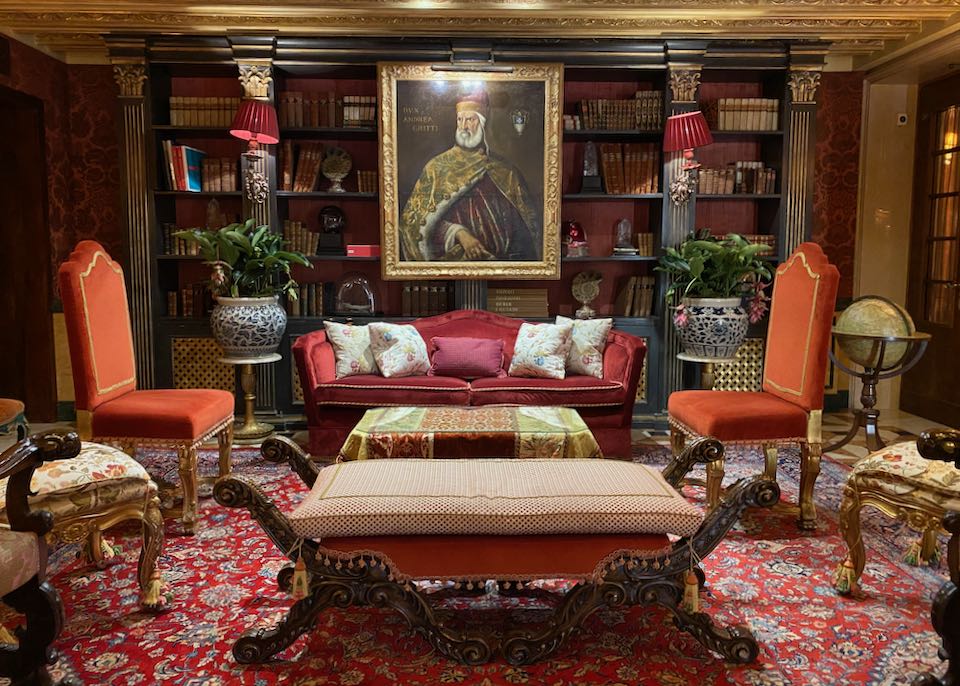
The sumptuous interior of the Gritti Palace Hotel.
The 10 Best Neighborhoods in Venice for Tourists
Note that hotel rates yo-yo more in Venice than almost any other city in the world – boutiques that charge $100 in January can charge over $300 in May.
1. San Marco
Even in a city brimming over with architectural wonders, nothing prepares you for Piazza San Marco. Venice’s largest and most impressive square has long been the city’s spiritual and political core, surrounded by such iconic buildings as the Basilica San Marco (St. Mark’s Cathedral), renowned for its stunning Byzantine mosaics and 318-foot (97m) bell tower, which provides sensational views of the city; the Gothic labyrinth that is the Palazzo Ducale (Doge’s Palace) and its Bridge of Sighs; and the Museo Correr, which contains a huge cache of archaeological artifacts and artwork, including Carpaccio’s Courtesans. You can also climb the square’s clock tower to see its inner workings. Though generally we recommend dining away from the touristy center, it’s worth spending some time in one of the “big three” historic cafés on the piazza, despite the extremely high prices: Caffè Florian (founded in 1720) is the oldest and has the most ornate interior, while Caffè Lavena was Wagner’s favorite and Gran Caffè Quadri features a posh restaurant.
Other attractions in San Marco’s tangle of narrow streets include the Scala Contarini del Bovolo, a stunning multi-arch spiral staircase, the famous Teatro La Fenice, the city’s historic opera house, and elegant department store T Fondaco dei Tedeschi, which has a roof deck offering fabulous views of central Venice. San Marco boasts plenty of designer shopping as well as two iconic bridges (Ponte dell’Accademia and Ponte di Rialto), and is the launching point for wonderfully scenic gondola rides along the narrow canals. However, San Marco is also Venice’s most crowded neighborhood; note that restaurants and bars tend to be pricier here than elsewhere, and it’s well worth buying tickets to its biggest attractions online to avoid waiting in long lines.
Numerous hotels lie between St Marks and the Rialto (with the most lavish and expensive hotels on the Grand Canal), making this the most central and convenient area to stay for sightseeing. Rates are very expensive, though, and it’s the most touristy/crowded part of the city. The best of the cheaper options are noted below.
- Best Hotels in San Marco
B&B Bloom Settimo Cielo • Hotel phone: +39 340 149 8872
Baglioni Hotel Luna • Hotel phone: +39 041 528 9840
Corte di Gabriela • Hotel phone: +39 041 523 5077
Egò Boutique – The Silk Road • Hotel phone: +39 041 639 9882
Gritti Palace • Hotel phone: +39 041 794611
Novecento Boutique Hotel • Hotel phone: +39 041 241 3765
Palazzo Barocci • Hotel phone: +39 041 296 0650
Sina Palazzo Sant’Angelo • Hotel phone: +39 041 241 1452
St Regis • Hotel phone: +39 041 240 0001- Best Cheap/Midrange Hotels
40.17 San Marco • Hotel phone: +39 393 913 4672
All’Angelo Art Hotel • Hotel phone: +39 041 520 9299
B&B Al Teatro • Hotel phone: +39 333 918 2494
Dimora Marciana • Hotel phone: +39 041 522 0755
Domus Ciliota • Hotel phone: +39 041 520 4888
Hotel Serenissima • Hotel phone: +39 041 520 00112. San Polo
Venice’s smallest sestiere is one of the liveliest. It’s also home to the Rialto – a tangle of ancient lanes that’s the city’s oldest settlement. In the 5th century, Venetians sought refuge here from Attila the Hun and started trading in lagoon fish – something which continues to this day at the Rialto Market. Apart from the Rialto Bridge that connects San Polo to San Marco, heavyweight attractions here include the Church of San Giacomo di Rialto (the oldest church in Venice), Campo San Polo (the second-largest square in Venice, surrounded by some excellent bars), the beautiful Scuola Grande di San Rocco (famed for its paintings by Tintoretto), and the Basilica Santa Maria Gloriosa dei Frari (final resting place of Titian and home to some of his best works). There’s also the family-friendly Leonardo da Vinci Museum, and Casa di Carlo Goldoni, historic home of the lauded Venetian playwright.
San Polo’s hotels tend to be much better value than San Marco’s across the Rialto, with many small, family-run B&Bs and guesthouses offering good rates, a smattering of more luxurious hotels, and lots of apartment rentals. Centrally located, this district is ideal for walking to all the main sights.
- Best Hotels in San Polo
H10 Palazzo Canova • Hotel phone: +39 041 520 0172
Locanda Sant’Agostin • Hotel phone: +39 041 822 3645
Palazzo Barbarigo • Hotel phone: +39 041 740172
Palazzetto Madonna • Hotel phone: +39 041 307 1174
Aman Venice • Hotel phone: +39 041 270 7333- Best Cheap/Midrange Hotels
Al Campaniel • Hotel phone: +39 041 275 0749
B&B Exclusive • Hotel phone: +39 333 291 9680
Ca’ San Rocco • Hotel phone: +39 041 716744
Pensione Guerrato • Hotel phone: +39 041 528 59273. Santa Croce
The least touristy of Venice’s sestieri, Santa Croce borders San Polo and Dorsoduro to the north. It encompasses some of the city’s major transport hubs, such as the Piazzale Roma bus station (and major vaporetto stop) and the main port. Its western part is not very scenic and is generally overlooked by visitors, but it is very convenient for public transport to other parts of Venice. Most of Santa Croce’s attractions are concentrated in the eastern part of the district and include the Ca’ Pesaro International Gallery of Modern Art, Oriental Art Museum, Natural History Museum, and the Mocenigo Palace-Museum. The neighborhood is home to some wonderful, unpretentious trattoria, with a cluster around or near the San Giacomo dell’Orio square, which also features a magnificent church.
The best hotels in Santa Croce tend to be on or near the Grand Canal, so rates tend to be high – there are a few cheap B&Bs and inns around, noted below. The Santa Croce district makes a good base for touring, set in between the transport hubs and St Marks, but less busy than San Marco.
Best Hotels in Santa Croce
AC Hotel Venezia • Hotel phone: +39 041 852 0321
Antiche Figure • Hotel phone: +39 041 275 9486
Canal Grande • Hotel phone: +39 041 244 0148
Hotel Olimpia • Hotel phone: +39 041 711041
Hotel Papadopoli • Hotel phone: +39 041 710400
Palazzo Odoni • Hotel phone: +39 041 275 9454
Santa Croce Boutique Hotel • Hotel phone: +39 041 740112Best Cheap/Midrange Hotels
Albergo Marin • Hotel phone: +39 041 718022
Hotel Dalla Mora • Hotel phone: +39 041 710703
Residenza d’Epoca San Cassiano • Hotel phone: +39 041 524 17684. Cannaregio
This former industrial sestiere in northwest Venice is particularly renowned for the Campo di Ghetto Nuovo – the central square of the world’s first Jewish ghetto (taking its name from the local word for “foundry”). Though Jews have lived in Venice since the 12th century, medieval Venice gave persecuted Jews fleeing from elsewhere in Europe an area of their own, with the proviso of a sunset curfew. The Museo Ebraico (Jewish Museum, currently closed for renovations) and the nearby synagogues (open for guided tours) are among the highlights in Cannaregio, as is the Strada Nova shopping street, Ca d’Oro (a beautiful Venetian palace and art gallery on the Grand Canal, containing Mantegna’s St. Sebastian), the Venetian Renaissance Church of Santa Maria dei Miracoli, and Church of Madonna dell’Orto (where the famed painter Tintoretto is entombed and some of this best works are displayed). Densely populated by Venetians, Cannaregio has a wonderfully ‘local’ feel to it and is also one of the most affordable parts of Venice to stay in. The train station is located here, and there are excellent vaporetto connections to other parts of the city.
This huge sestiere where most locals live is another one of our favorites; a bit grittier than the rest of the city and away from main tourist areas, but convenient for the train station. Rates are generally cheaper for luxury hotels here, but budget hotels are of mixed quality – exceptions listed below.
- Best Hotels in Cannaregio
Ai Mori d’Oriente • Hotel phone: +39 041 711001
Al Ponte Antico • Hotel phone: +39 041 241 1944
Ca’ Bonfadini • Hotel phone: +39 041 098 6298
Ca’ Sagredo • Hotel phone: +39 041 241 3111
Arcadia Boutique Hotel • Hotel phone: +39 041 717355
Palazzo Nani Venice • Hotel phone: +39 041 884 2200
Venice Times • Hotel phone: +39 041 203 1633
The Venice Venice • Hotel phone: +39 041 097 0300- Best Cheap/Midrange Hotels
Ca’ Fontanea • Hotel phone: +39 345 616 6692
Ca’Pozzo Inn • Hotel phone: +39 041 524 0504
Casa Martini • Hotel phone: +39 041 7175125. Dorsoduro
South of San Marco, Dorsoduro is the city’s most vibrant sestiere, but still maintains a very local vibe. There’s a wealth of sights here, a lively produce market on the main square, plenty of wallet-friendly eateries catering to the student population of the Ca’ Foscari University, and a cluster of bars around Campo Santa Margherita that get busy in the evenings. Dorsoduro’s top attractions include the Gallerie dell’Accademia (Venice’s most famous art gallery), the wealth of modern art inside the Peggy Guggenheim Collection, the baroque extravagance of the Ca’Rezzonico canalside palace (with works by Tintoretto and Tiepolo), and the Church of San Sebastiano, home to some of Paolo Veronese’s finest work. Fans of Tiepolo should visit the Scuola Grande dei Carmini, which he decorated between 1739 and 1744. The most impressive landmark along the Grand Canal is Dorsoduro’s iconic dome of Santa Maria della Salute, which contains paintings from Titian, plus Tintoretto’s Marriage at Cana.
This district also features the very interesting Squero di San Trovaso, the workshop for traditional Venetian boats and gondolas on the Rio San Trovaso (close to the Accademia Bridge). You can observe the action with a spritz and ciccetti from Osteria al Squero across the canal.
Dorsoduro is our overall favorite sestriere – featuring beautiful canals and palazzos, a wealth of art, inviting restaurants, yet only a fraction of the San Marco crowds. You’ll find excellent budget guesthouses, B&Bs, and apartments rentals here, but also plenty of more upscale offerings.
- Best Hotels in Dorsoduro
American Dinesen • Hotel phone: +39 041 520 4733
Ca Maria Adele • Hotel phone: +39 041 520 3078
Ca’ Pisani • Hotel phone: +39 041 240 1411
Moresco • Hotel phone: +39 041 244 0202
Nani Mocenigo Palace • Hotel phone: +39 041 520 0145
Palazzo Veneziano • Hotel phone: +39 041 277 8719
Sina Centurion Palace • Hotel phone: +39 041 34281- Best Cheap/Midrange Hotels:
Ca’ della Corte • Hotel phone: +39 041 715877
Casa Accademia • Hotel phone: +39 041 522 2755
Pensione Accademia • Hotel phone: +39 041 521 0188
Santa Margherita Guest House • Hotel phone: +39 327 854 17106. Castello
Sitting just to the east of San Marco, Castello is the largest of Venice’s sestieri but is much quieter than its showy neighbor (away from the busy Riva degli Schiavoni waterside promenade), and is a very authentic place to stay. Here you can wander the narrow streets and observe kids playing soccer in the tiny squares, and locals exchanging gossip from their windows. Much of Castello lies within easy walking distance of some of the city’s biggest attractions, minus San Marco’s crowds.
Dating back to the 13th century, Castello is centered on the pavilions in the Giardini della Biennale (a rare green space in Venice) and the historic Arsenale shipyard and naval complex, host to the annual Venetian Biennale art and architecture exhibition. Other highlights include the church of Santi Giovanni e Paolo (also known as Zanipolo and housing the tombs of 25 doges), famous artwork by Giovanni Bellini inside the San Zaccaria church, stunning decorations by Carpaccio inside the 15th-century Scuola di San Giorgio degli Schiavoni, and the beautiful Santa Maria Formosa church and square. The vast Museo Storico Navale di Venezia will appeal to lovers of maritime history. Bibliophiles will adore Libreria Acqua Alta, a charming bookstore packed to the rafters with used volumes, many stuffed into boats and bathtubs to preserve them in case of high tide.
The Biennale d’Arte is one of the world’s most prestigious international art shows, filling the pavilions of the Giardini (public gardens) at the east end of Castello and at the Arsenale, as well as churches all over the city. It usually runs April to November every other year – the next show is due in 2026. If the Biennale is not on, you can still walk up to the Ponte del Paradiso, the iconic twin-towered entrance to the Arsenale.
Hotels in Castello tend to get cheaper the further they are from San Marco, though there are not as many good budget hotels as you’d expect. Also note that during the Biennale, everything gets booked solid.
- Best Hotels in Castello
Ai Reali • Hotel phone: +39 041 241 0253
Ca’ di Dio • Hotel phone: +39 041 098 0238
Hotel Danieli • Hotel phone: +39 041 522 6480
Hotel Indigo Sant’Elena • Hotel phone: +39 041 271 7811
Londra Palace • Hotel phone: +39 041 520 0533
Palazzo Vitturi • Hotel phone: +39 041 241 0856
Ruzzini Palace • Hotel phone: +39 041 241 0447- Best Cheap/Midrange Hotels
B&B San Marco • Hotel phone: +39 347 244 2237
Bisanzio • Hotel phone: +39 041 520 3100
Cà Del Dose • Hotel phone: +39 041 520 9887
Locanda La Corte • Hotel phone: +39 041 241 1300
La Residenza • Hotel phone: +39 041 528 53157. Giudecca
Venice’s unofficial seventh sestiere, but officially part of Dorsoduro, Giudecca sits south across the canal from Dorsoduro and San Marco, and consists of several small islands linked by bridges. In the 9th century, it was a prison island, home to aristocratic rebels banished from Venice proper. Later, it became a retreat for nobles, then an enclave of factories and military barracks. Today, it attracts young creative types who have priced out of other sestieri, and is dotted with artists’ studios and independent shops. Apart from its sedate atmosphere and terrific views of Venice proper, Giudecca’s highlights include a monastery and several churches, including the grand Chiesa del Santissimo Redentore, designed by Andrea Palladio. The iconic church of San Giorgio Maggiore (on the neighboring island of the same name) is another beauty by Palladio containing work by Tintoretto and a bell tower with stellar views. Several vaporetti connect Giudecca and San Giorgio Maggiore to San Marco and Dorsoduro.
Giudecca is the most tranquil part of central Venice. Travelers staying here get the best views of St Marks and the city, but will be more reliant on boats to get around. There are several good quality upscale hotels in Giudecca, with a smattering of cheaper apartments and guesthouses, but there choice of accommodation here is small compared to the main sestieri.
- Best Hotels in Giudecca
Al Redentore Di Venezia • Hotel phone: +39 041 522 9402
Cipriani • Hotel phone: +39 041 240801
Hilton Molino Stucky • Hotel phone: +39 041 272 33118. Lido de Venezia
A long, narrow barrier island to the east of Venice proper, Lido can be a bit of a shock to the system after Venice; with its regular streets dotted with art deco buildings and cars instead of medieval lanes and canals, it feels more like an upscale French beach resort. Lido was once a sandy retreat for European aristocracy and Hollywood stars, and though it isn’t quite as glamorous as in years past, it’s the one place near Venice with a proper sandy beach (though the Adriatic is a chilly swim). It’s a fun place for a day trip, even if you don’t stay here, with some decent seafood restaurants along the main drag, Granviale Santa Maria Elisabetta (aka Gran Viale). In September, it hosts the Venice Film Festival. Vaporetto line nos. 1, 2, 5.1, 5.2, and LN cross the lagoon to the Lido from the San Zaccaria–Danieli stop near San Marco.
Staying here is a totally different experience than in the rest of Venice. It can be appealing in the summer, but it’s not convenient for exploring the city, so consider the Lido only if being near a beach is a top priority. In winter it can feel quite desolate, and not much is open.
- Best Hotels on Lido de Venezia
Ausonia Hungaria • Hotel phone: +39 041 242 0060
Hotel Excelsior • Hotel phone: +39 041 526 0201
Hotel Villa Laguna • Hotel phone: +39 041 526 1316
Hotel Villa Stella • Hotel phone: +39 041 526 0745- Best Cheap/Midrange Hotels
Hotel La Meridiana • Hotel phone: +39 041 526 0343
New Reiter Hotel • Hotel phone: +39 041 098 6260
Petit Palais • Hotel phone: +39 041 526 4030
9. Murano
Composed of seven sections, separated by canals and linked by bridges, the island of Murano, just north of Venice proper, has a long and distinguished history as part of the Venetian Republic. Venetians have been practicing glass-making since the 10th century, and in the 13th century the whole industry was moved to Murano to contain its fire hazards. The art of glass-making is still very much alive on the island, with a Glass Museum and numerous glass workshops and showrooms for visitors to explore. Murano is a wonderfully serene place to stay, offering a few hotels and guesthouses, a smattering of good restaurants, and a couple of historic churches worth exploring: 15th-century San Pietro Martire, containing work by Veronese and Bellini, and the much older Santi Maria e Donato, with its beautiful Byzantine mosaics. Murano is reachable by frequent vaporetto rides (10 minutes) from the Fondemente Nove dock in Cannaregio.
Murano is home to a handful of hotels, some of which very luxurious. Though it’s not far by boat from the main part of Venice, it’s not very convenient if you aim to do a lot of sightseeing. It also tends to be much quieter at night, when the day-trippers have gone and you’ll definitely feel more like a local.
- Best Hotels on Murano
Hyatt Centric Murano • Hotel phone: +39 041 273 1234
Murano Suites • Hotel phone: +39 331 546 4313
NH Collection Murano Villa • Hotel phone: +39 041 273 1311- Best Cheap/Midrange Hotels
Ca’ Del Pomo Granà • Hotel phone: +39 347 083 3785
Casa Sulla Laguna • Hotel phone: +39 335 210 42910. Burano & Mazzorbo
At the northern end of the Venetian Lagoon, Burano has long been renowned for its intricate lacework that used to adorn Europe’s aristocracy. Lace-making still survives here as a craft, with workshops and a small Lace Museum that visitors can explore. It’s also a wonderful place to wander, admiring the colorful and picturesque fishermen’s houses that line the canals here. It’s worth staying overnight on Burano to experience the island’s distinctive vibe and cuisine (the specialty is risotto de gò, prepared with a particular type of lagoon fish). A bridge connects Burano to the adjacent, quiet island of Mazzorbo, home to some of the best wine in Venice. Burano is a 50-minute vaporetto #12 ride from the Fondemente Novedock in Cannaregio via Murano.
Burano is the most beautiful and atmospheric outer island, but it’s quite a hassle to travel by boat back and forth from the city – stay here if this is your second visit and you want to spend more time in the outer islands. There are only a couple of decent choices when it comes to hotels, though apartment rentals are also an option.
- Best Hotels on Burano & Mazzorbo
Casa Burano • Hotel phone: +39 041 527 2281
Venissa Wine Resort • Hotel phone: +39 041 527 2281Venice Travel Tips
- Venice Marco Polo Airport lies on the mainland around 5 miles north of Venice. It’s well connected to cities all over the world, with summer non-stop flights from New York, Atlanta, and Newark. You can take taxis and buses into Venice itself, but these will drop you at the end of the causeway at Piazzale Roma and you’ll have to walk or take a ferry to your destination from there. By far the most romantic way into the city is by boat: for just €15, Alilaguna ferries run from a dedicated airport dock into the city, with stops along the Grand Canal, Murano, and the Lido. Expect private water taxis from the airport to charge at least €115.
- In 2024, Venice launched a trial daily tourist tax for day-trippers, which will continue in 2025 with adjustments. Visitors aged 14+ not staying overnight must book a €5 entry ticket in advance for select days (mainly weekends and holidays). The fee rises to €10 if booked less than four days in advance. A QR code will be issued for potential checks at entry points. Overnight guests, Veneto residents, children under 14, and people with disabilities are exempt, as hotel guests already pay a nightly tourist tax.
- Almost everyone you are likely to deal with in Venice will be able to speak (or at least understand some) English, except for a few boat drivers and owners of small cafés/shops. Still, it’s a worthwhile to learn a few key words, phrases, and numbers in Italian before you go. Note that if you head out of the city for a day trip, things change dramatically – few people in rural Veneto speak English, especially among the older generation.
- The Venezia Unica City Pass is the all-in-one buildable tourist card sponsored by the city, with options that include public transportation, admission to tourist attractions and cultural events, and even wi-fi access; custom-load your pass on the website for trips of 1, 2, 3, and 7 days. It can be good value assuming you intend to visit a lot of major sights in a short amount of time. The Chorus Pass gives free admission to 17 churches across Venice for up to 1 year for only €12 (most of them charge €3 otherwise).
- Bike use is banned in Venice itself, but renting one to explore the Lido can be a good idea in the summer; several rental shops operate near the ferry dock at Santa Maria Elisabetta.
- The official fixed rate for gondola rides is €80 for 30 minutes for up to six passengers; the rate increases to €100 from 7pm to 8am.
- Free wi-fi is available at Venice Marco Polo Airport, and at some cafés and bars throughout the city. Access to over 200 wi-fi hotspots can be added as part of the Venezia Unica City Pass (€5 for 24hr, €15 for 72hrs and just €20 for one week).
- It pays to book ahead online for the Palazzo Ducale, St Marks Basilica, and the Accademia. This guarantees you an entry time, avoiding what is often a very long ticketing line.
More Venice Neighborhoods
We’ve covered our favorite neighborhoods to visit and stay in more detail above, but with more time the following areas are also worth checking out. Note that you can also reach major tourist destinations such as Padua, Vicenza, and Treviso extra fast using cheap local trains from Venice.
- Outer islands: Rustic Torcello was once a booming medieval city, but today just one canal leads from the dock to a cluster of its remaining buildings; a fascinating archeology museum and the 7th-century Basilica di Santa Maria dell’Assunta, which contains stunning Byzantine mosaics. The best place to stay here is the historic restaurant and inn Locanda Cipriani. For something even more exclusive, consider the luxurious San Clemente Palace Kempinski, on the private island of San Clemente south of the city, or the nearby JW Marriott Venice Resort & Spa on the private island of Isola delle Rose. You can also take a vaporetto to the 18th-century Armenian Monastery on San Lazzaro degli Armeni (which Lord Byron visited in 1816), and the asylum museum on the neighboring island of San Servolo.
- Mestre: Mainland Venice is known as Mestre (served by Venezia Mestre station), a modern industrial center that holds little interest other than as a cheap base from which to make forays into Venice proper. There are some large, comfortable hotels just outside the station that offer much lower rates than comparable hotels across the water: Best Western Plus Hotel Bologna, Hotel Plaza, Leonardo Royal, and Campanile Venice-Mestre. Regular trains zip across the lagoon in around 10–15 minutes for just a few euros, but because you’re staying on the mainland, you’ll need to pay the daily Venice tourist tax when applicable.
- There’s no reason to stay near Venice Marco Polo Airport on the mainland unless you have a very early or late flight. If you do need to spend the night, the best hotels are the good value B&B Airport Venice Diego and Dolce Laguna Bed and Breakfast; Courtyard is the only major chain hotel nearby.
Summary: My Favorite Hotels in Venice
• 5-star: Gritti Palace
• 4-star: Santa Croce Boutique
• 3-star: La Residenza
• For couples: Egò the Silk Road
• For families: Bisanzio
• Near train station: Venice Times
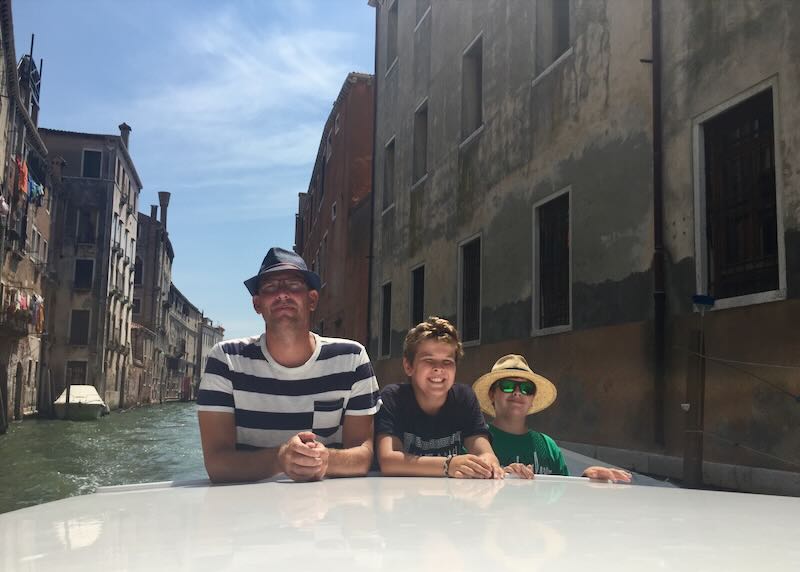
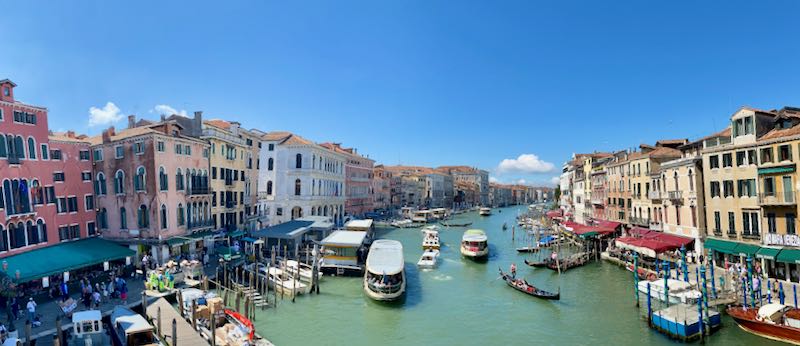
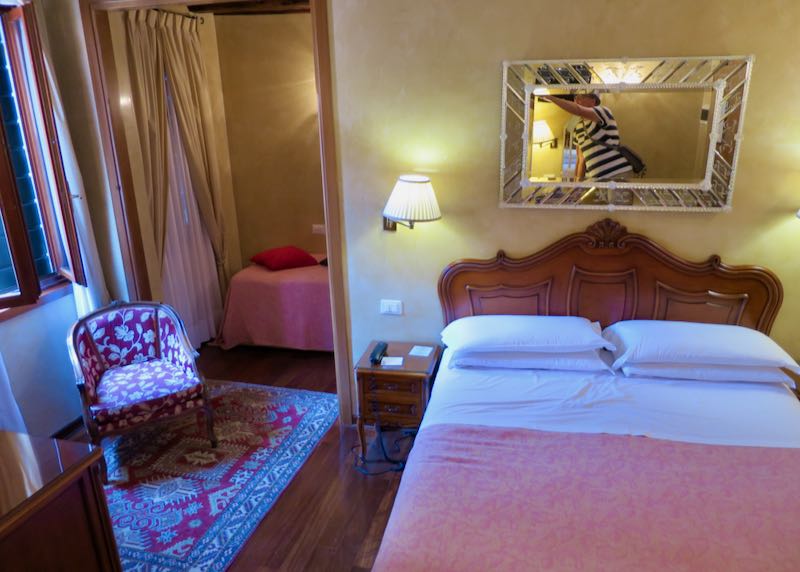
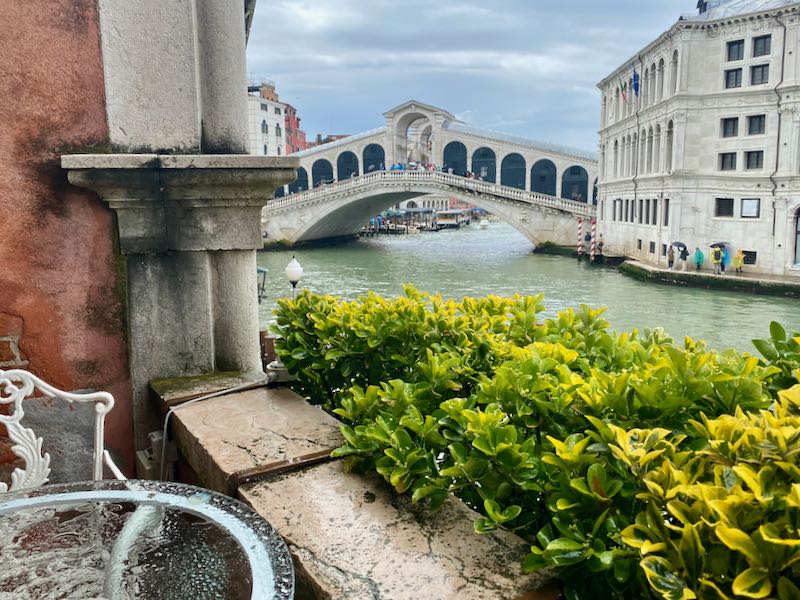
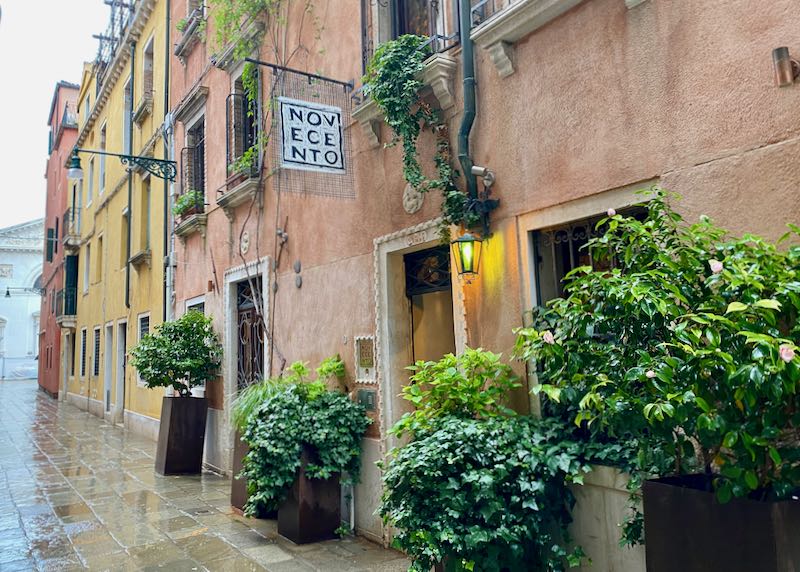
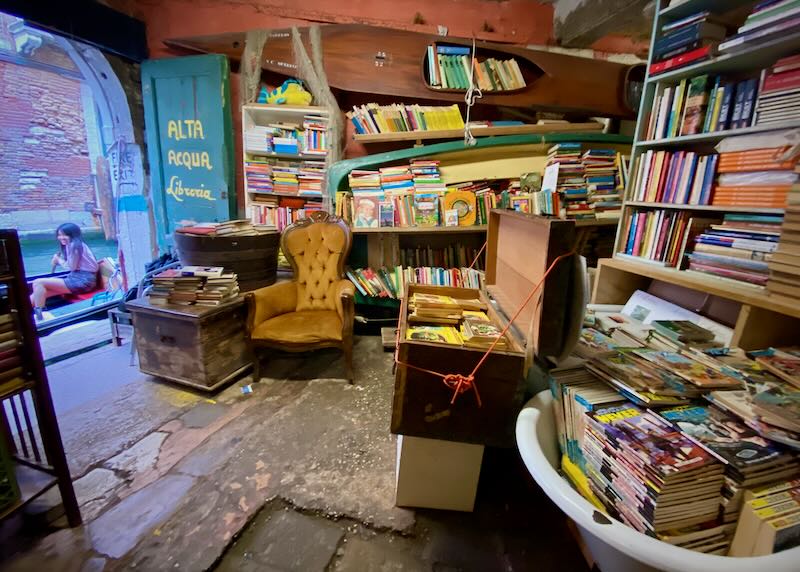
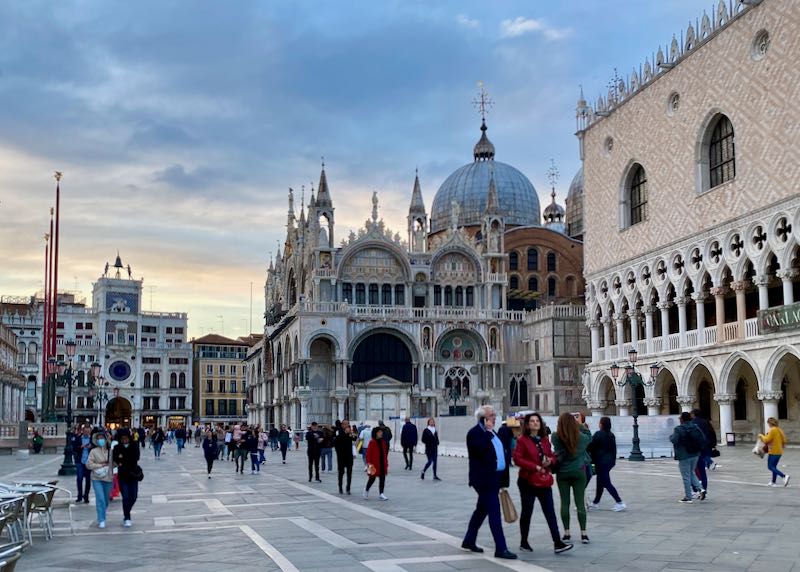
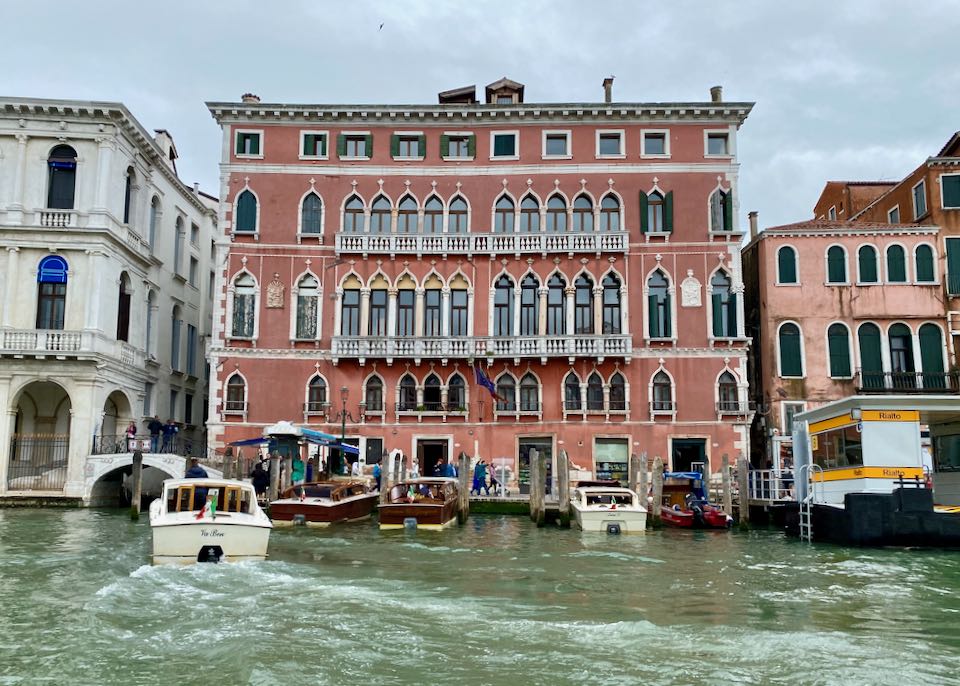
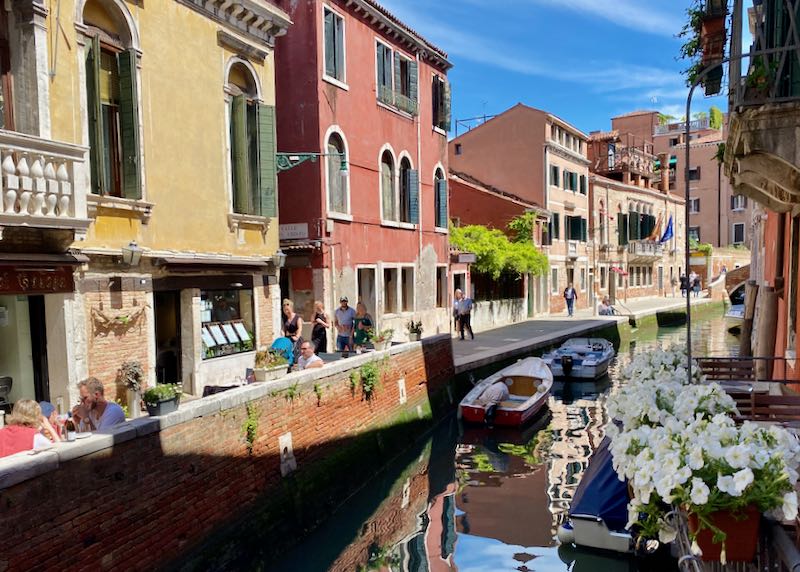
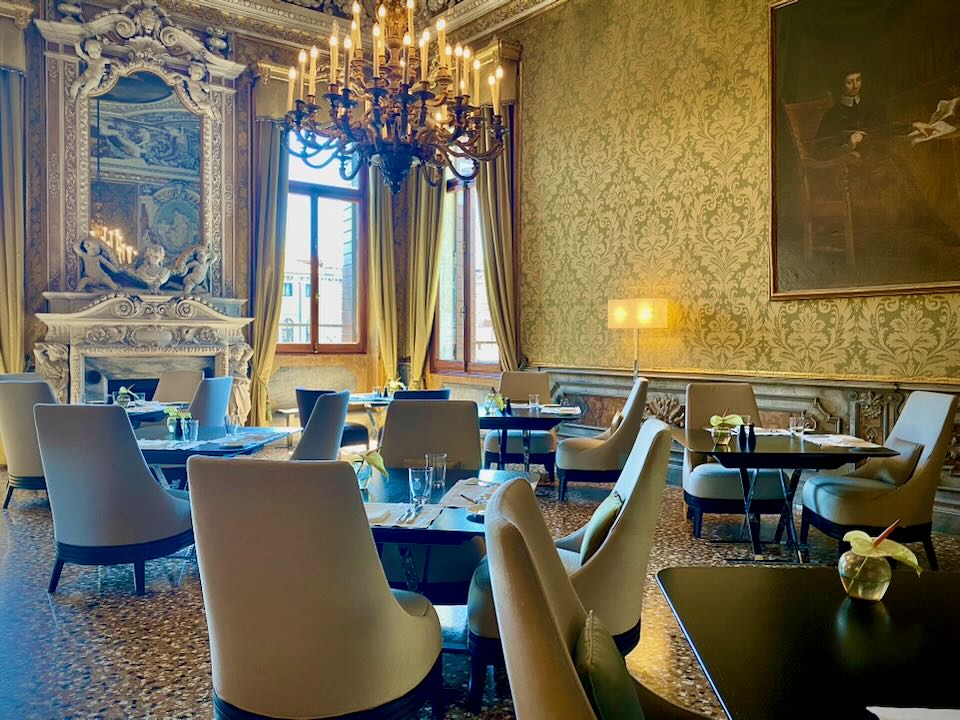
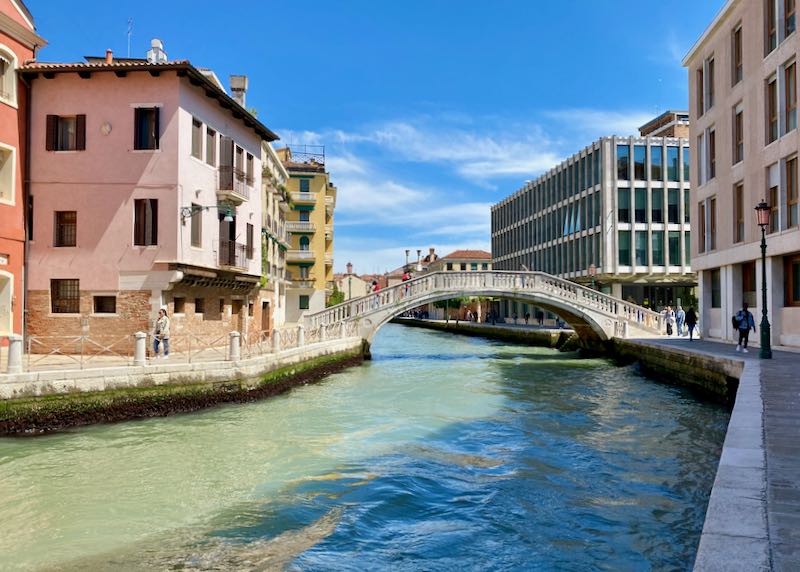
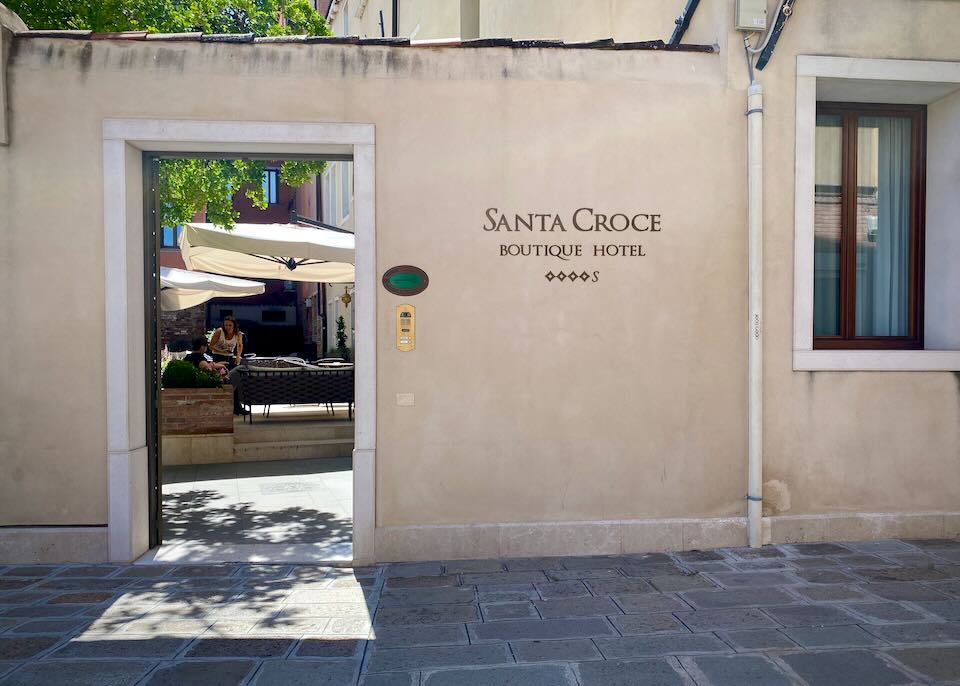
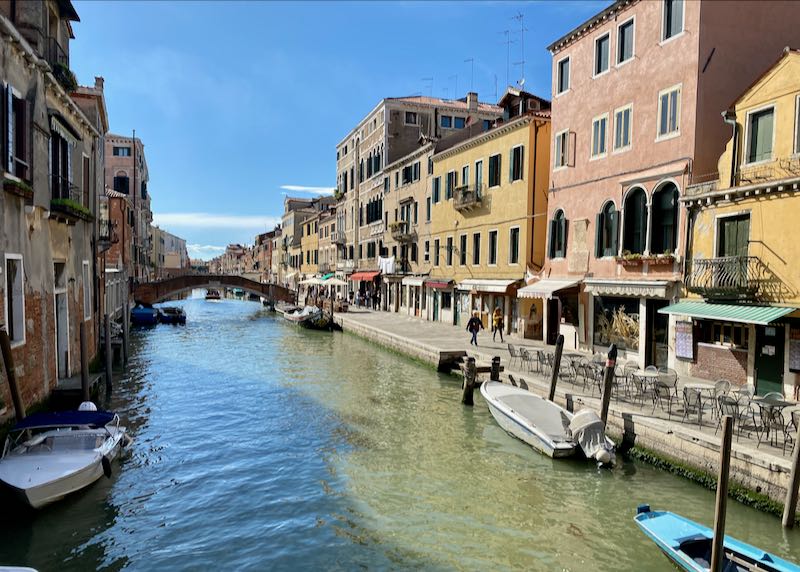
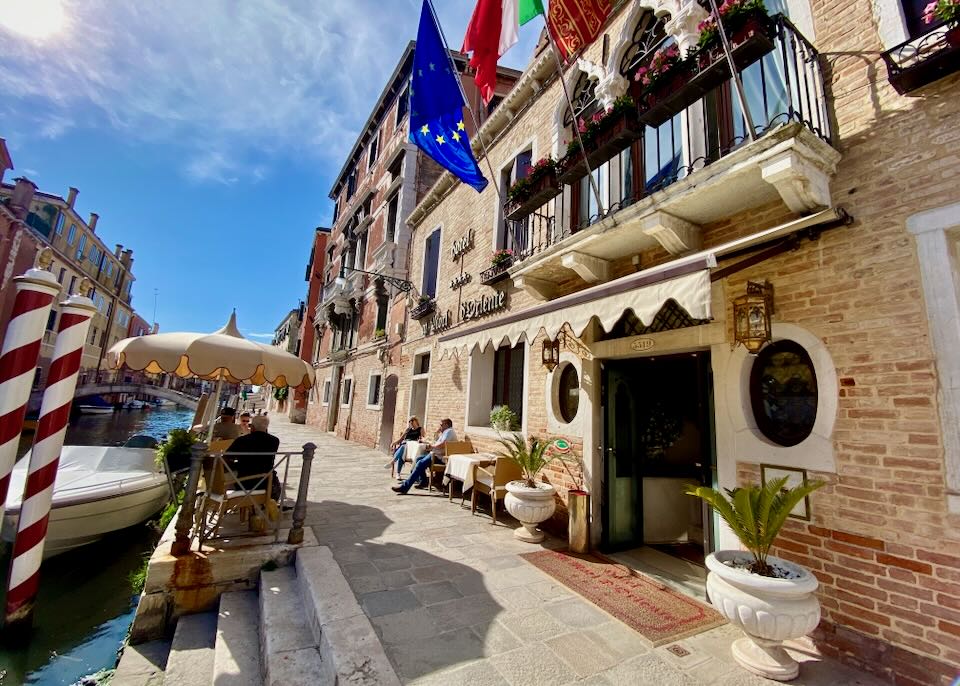
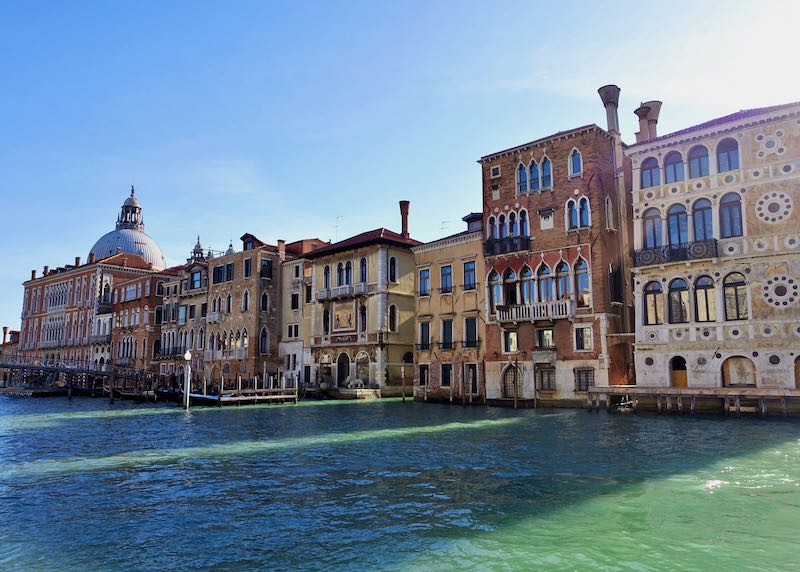
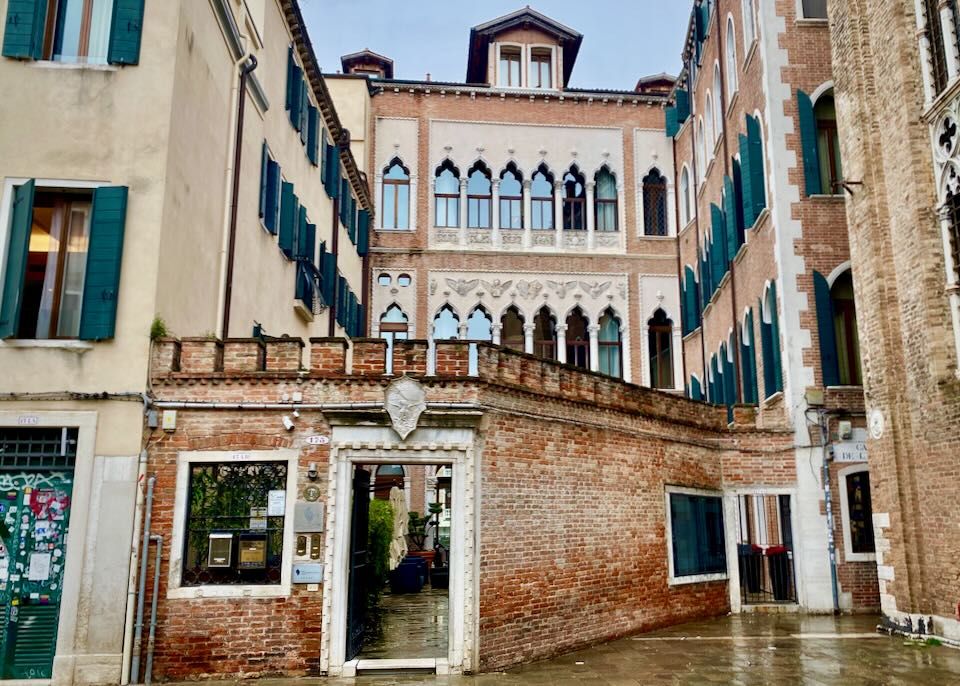
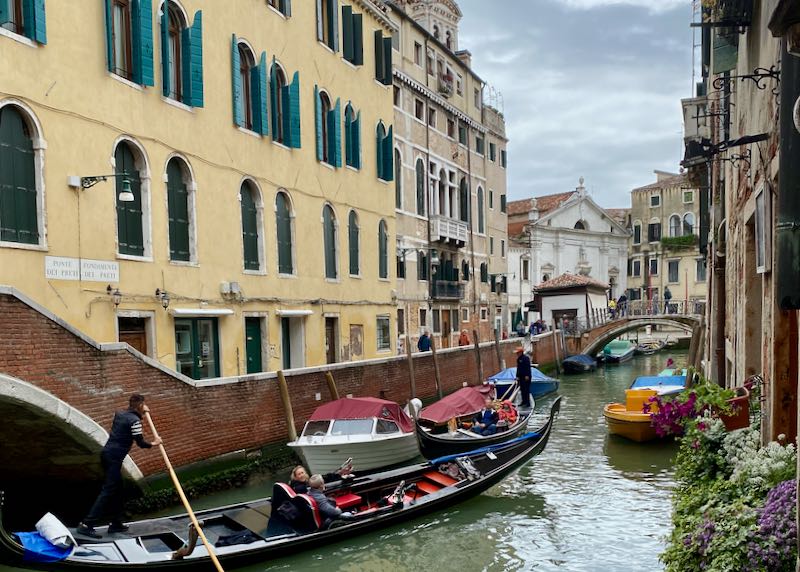
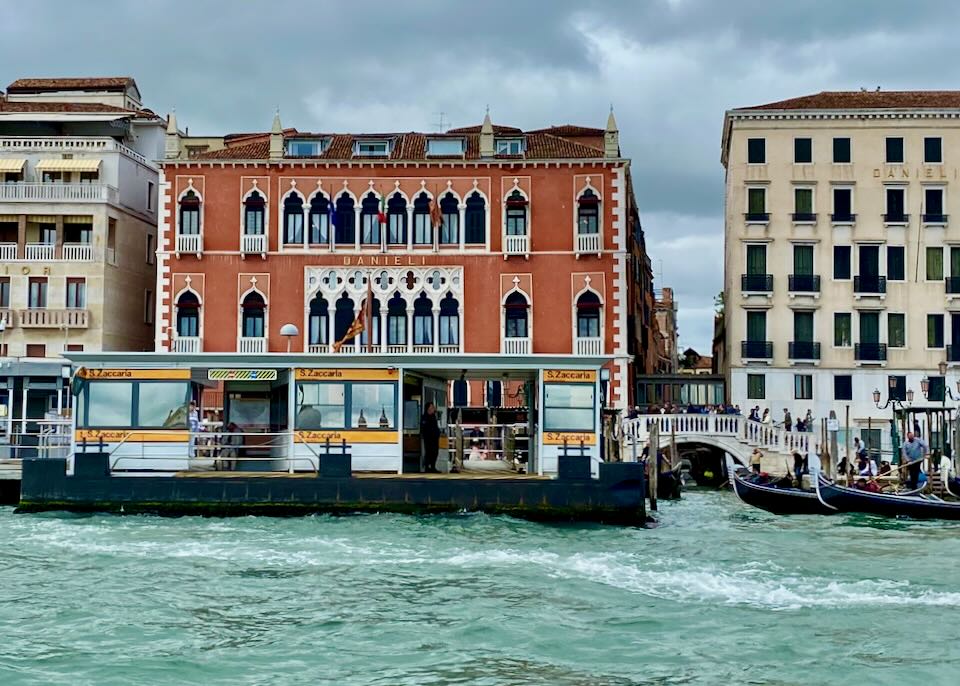
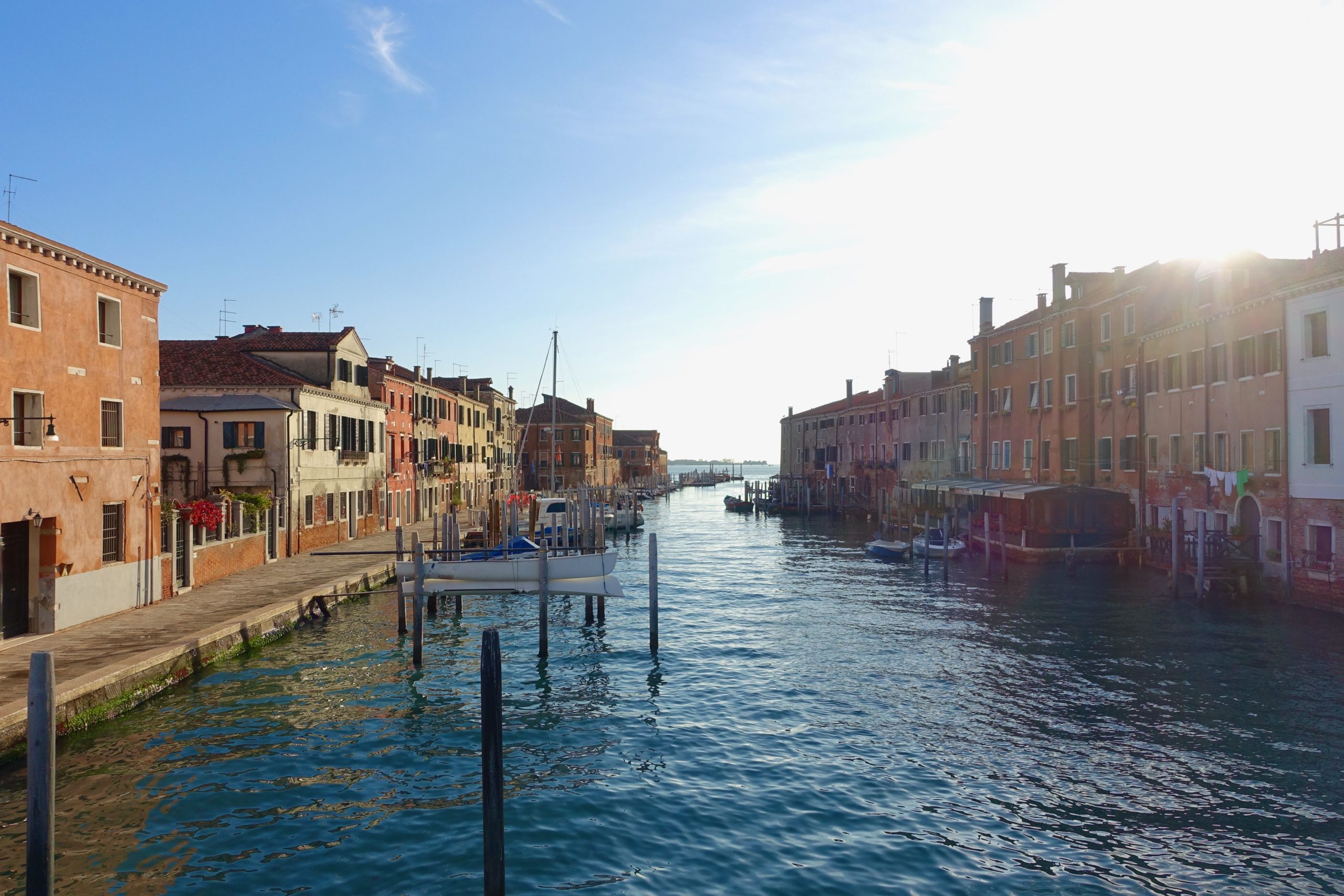
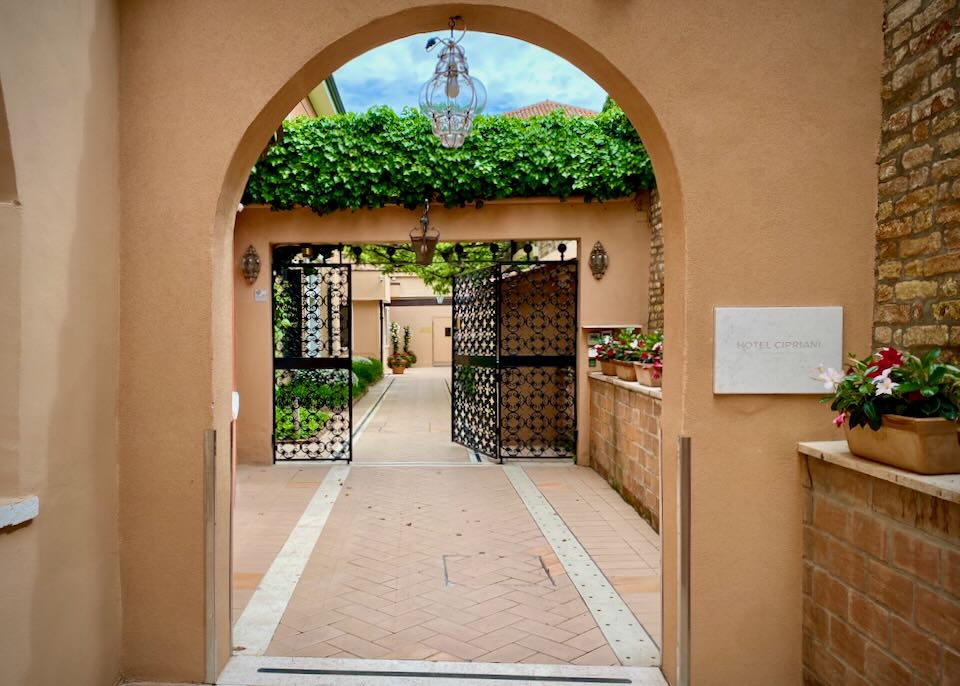
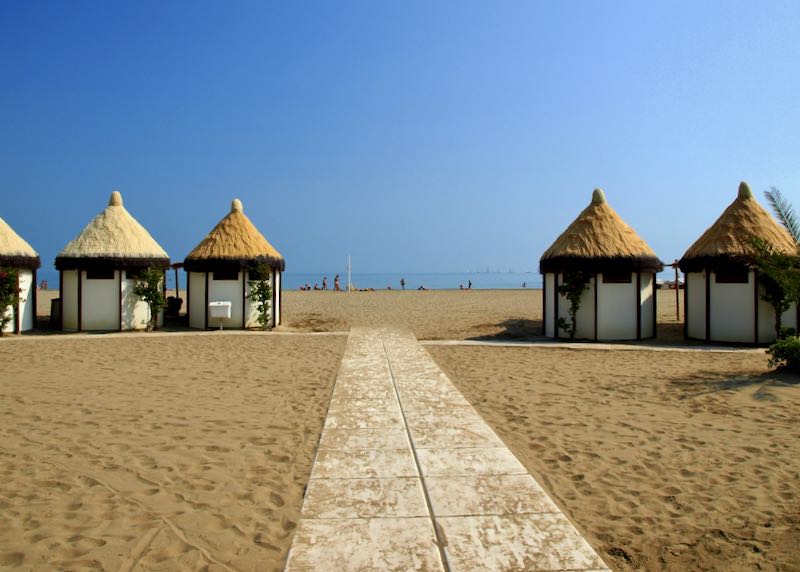
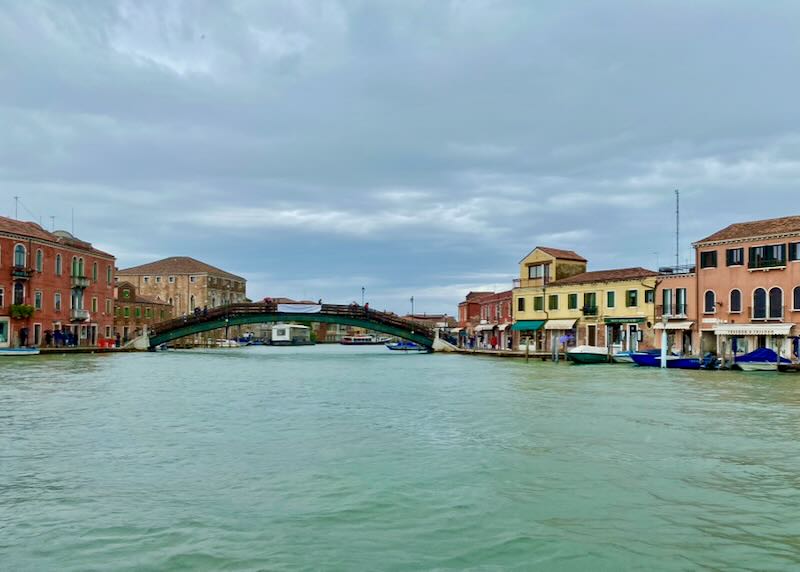
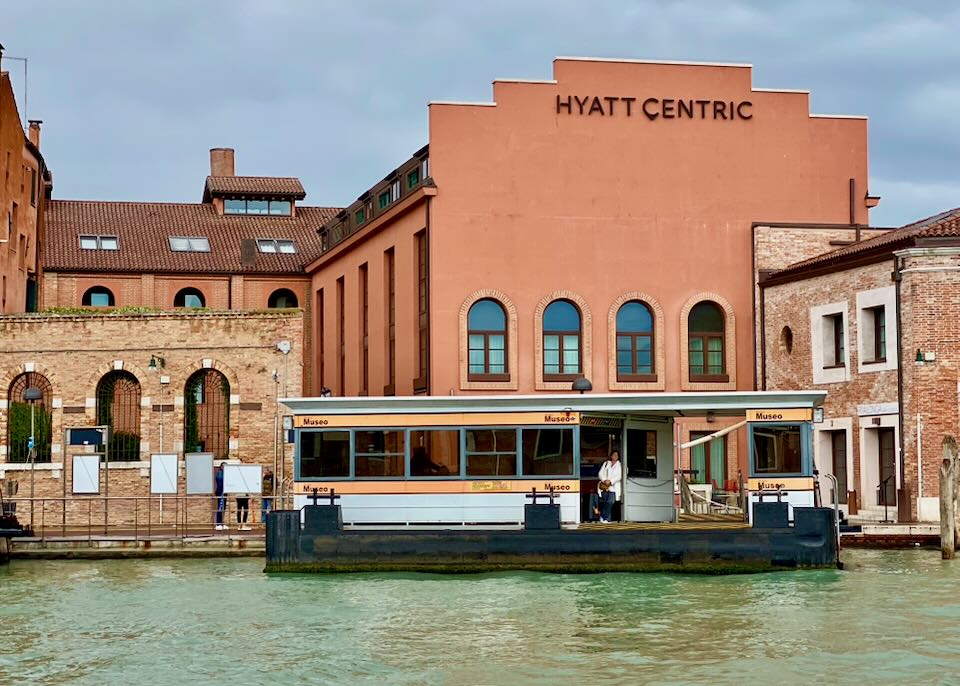
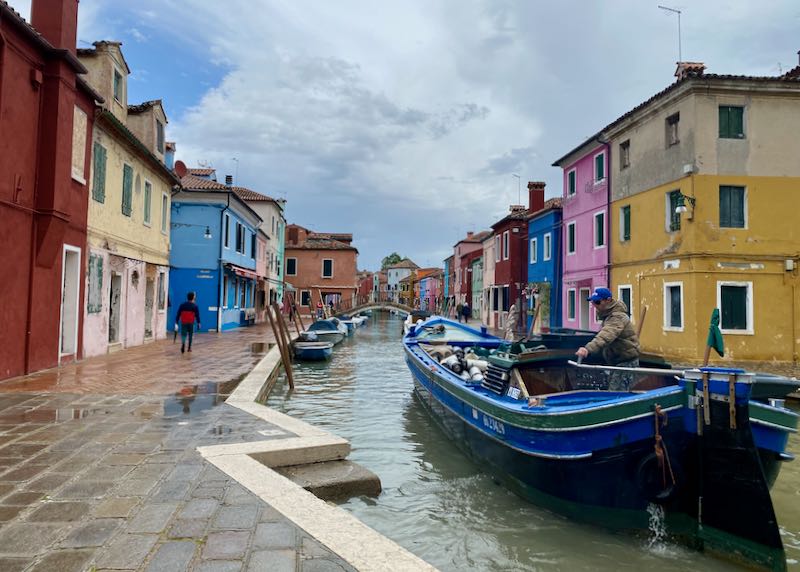
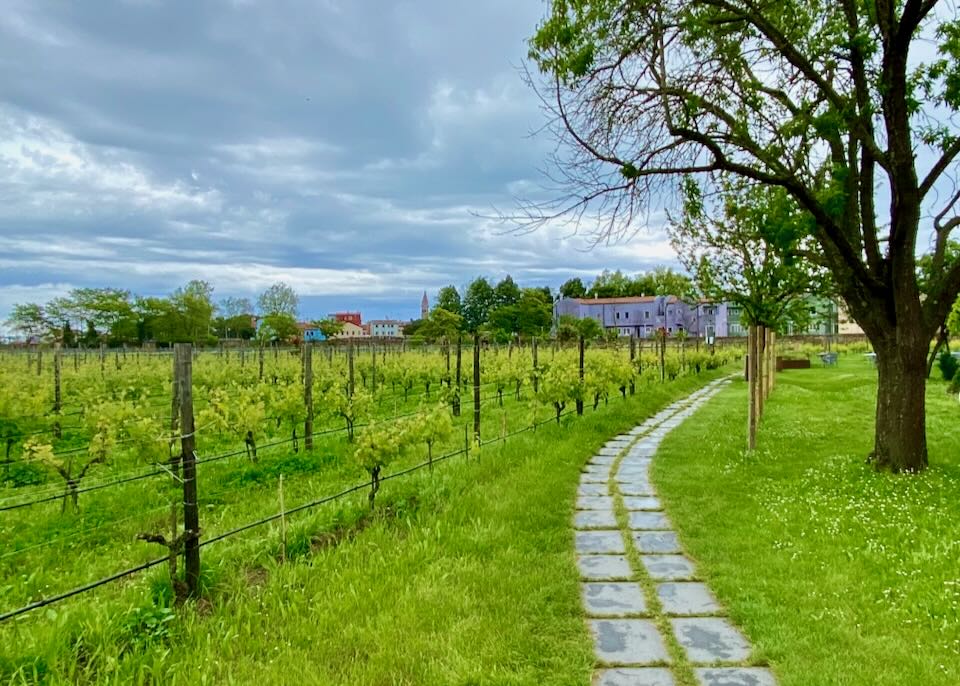
About Santorini Dave